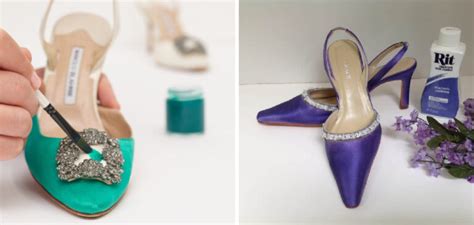Dye Your Satin Shoes to Match Your Outfit: A Step-by-Step Guide
Satin shoes are the epitome of elegance, adding a touch of glamour to any outfit. But what happens when your favorite pair doesn't quite match your stunning new dress? Don't despair! Dyeing your satin shoes is a surprisingly achievable project that can breathe new life into your footwear collection and allow you to perfectly coordinate your look. This comprehensive guide will walk you through the process, ensuring you achieve professional-looking results.
Why Dye Satin Shoes?
Before we dive into the how-to, let's explore why dyeing your satin shoes is a worthwhile endeavor. Beyond matching your outfits, dyeing offers several benefits:
- Extend the life of your shoes: Instead of discarding beloved shoes because of a color mismatch, dyeing provides a cost-effective way to revitalize them.
- Unique personalization: Dyeing allows you to create truly unique shoes, reflecting your personal style and adding a bespoke touch to your wardrobe.
- Cost savings: Dyeing is significantly cheaper than buying a new pair of shoes, especially designer satin ones.
- Creative expression: Experiment with different colors and techniques to achieve a range of effects, from subtle shading to vibrant hues.
What Kind of Dye Should I Use for Satin Shoes?
Choosing the right dye is crucial for a successful outcome. Avoid using dyes intended for fabrics like cotton or wool, as these may not bond properly with satin's delicate fibers. Instead, opt for fabric dyes specifically designed for synthetic materials or silk. These dyes are formulated to penetrate the fibers effectively without damaging the satin's delicate sheen. Always check the dye's instructions to ensure it's suitable for satin or silk. Many craft stores offer a variety of colors and types, including liquid, powder, and even fabric markers for smaller touch-ups.
What if my satin shoes are already dyed?
Dyeing over an existing color is possible, but the final result will depend on the original color and the new dye you choose. Darker dyes are generally more effective at covering lighter colors. It is always best to test a small, inconspicuous area of the shoe first to see how the new dye takes to the existing color.
Step-by-Step Guide to Dyeing Satin Shoes
This detailed guide assumes you're using a liquid fabric dye. Always refer to the specific instructions provided with your chosen dye.
1. Preparation is Key:
- Clean your shoes thoroughly: Remove any dirt, grime, or previous polish using a mild detergent and lukewarm water. Allow them to dry completely before proceeding. Any residue will affect the dye's absorption.
- Protect your workspace: Cover your work surface with newspaper or plastic sheeting to avoid staining. Wear gloves to protect your hands.
- Prepare the dye bath: Follow the dye manufacturer's instructions precisely regarding water temperature and dye-to-water ratio.
2. Dyeing Process:
- Submerge the shoes: Carefully submerge your satin shoes in the dye bath, ensuring they are fully immersed.
- Stir gently: Gently stir the dye bath to ensure even color distribution. Avoid harsh scrubbing which could damage the satin.
- Monitor the time: Follow the dye instructions carefully regarding the dyeing time. Over-dyeing can lead to uneven coloring or damage.
3. Rinse and Dry:
- Rinse thoroughly: Once the dyeing time is complete, carefully remove the shoes from the dye bath and rinse them thoroughly under cool, running water until the water runs clear.
- Air dry: Allow the shoes to air dry completely away from direct sunlight or heat. Direct heat can damage the satin and potentially cause the dye to bleed.
4. Finishing Touches:
- Conditioning: Once the shoes are completely dry, you may consider applying a satin protector or conditioner to help maintain the sheen and color vibrancy.
Troubleshooting Common Problems
Uneven Dye: This usually results from inadequate stirring or insufficient dyeing time. If this occurs, repeat the process, ensuring even immersion and following the dye instructions carefully.
Color Bleeding: This might happen if the shoes weren't rinsed thoroughly enough. Rinsing under cool water until the water runs clear is crucial to prevent bleeding.
Damaged Satin: This is usually due to harsh scrubbing or incorrect dye selection. Always use a dye appropriate for synthetic or silk fabrics and avoid harsh scrubbing during the dyeing process.
FAQs:
Can I dye only part of my satin shoes?
Yes, you can achieve tie-dye effects or dye only specific areas of your shoes using techniques like rubber banding or masking. This requires a little more finesse and may involve using fabric markers for smaller, detailed work.
How long will the dye last?
The longevity of the dye depends on several factors, including the quality of the dye, the type of satin, and how often the shoes are worn. Proper care, including avoiding harsh chemicals and cleaning methods, will help extend the life of the dye.
Can I machine wash my dyed satin shoes?
It's best to hand wash dyed satin shoes to avoid potential damage or color bleeding.
Dyeing satin shoes offers a fantastic opportunity for creative expression and cost-effective fashion. By following these steps and paying attention to detail, you can successfully dye your shoes and elevate your style game, one perfectly matched outfit at a time. Remember to always prioritize safety and carefully follow the instructions of the dye you choose.

